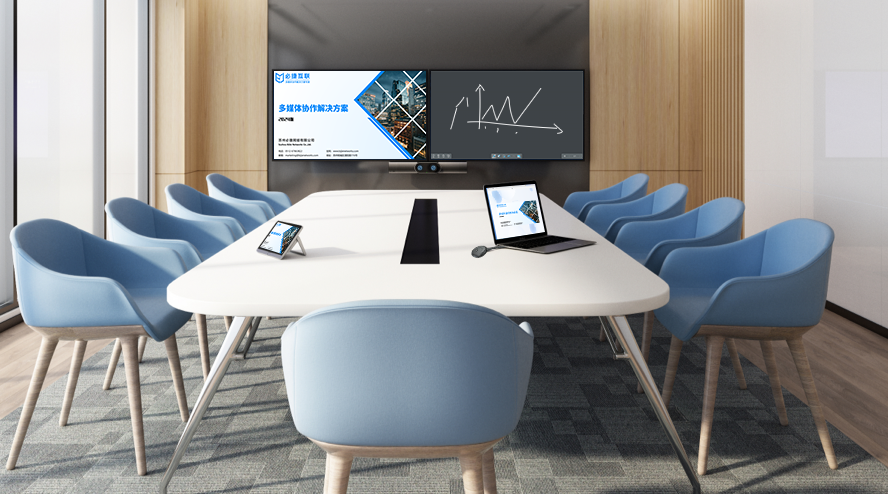Use This for AirPlay: Smoother Screen Mirroring for Apple Devices
Do you want to achieve a “seamless connection” between your iPhone, iPad, and Mac and a large screen? This screen mirroring device makes it easy! It’s deeply optimized for the native AirPlay protocol, allowing for one-click connection to enable content flow and two-way control without complex setup. It covers office collaboration, home entertainment, and educational interaction scenarios, making multi-screen interaction within the Apple ecosystem more effortless and efficient.
2 Steps to Start AirPlay Collaboration: Zero-Hurdle for Apple Users
This device fully aligns with Apple’s user habits, so you don’t need to be a tech expert:
- Quick Hardware Connection: Plug the receiver into your large screen (TV / meeting display / projector). Once powered on, the large screen will show a dedicated AirPlay name (e.g., “Study AirPlay Screen,” “Conference Room Apple Linkage Screen”). Connect your iPhone, iPad, and Mac to the same Wi-Fi as the device—no additional software installation is needed.
- One-Click Mirroring: On your iPhone/iPad, swipe down from the top right to open the Control Center and tap “Screen Mirroring.” On your Mac, click the “AirPlay” icon in the menu bar. Select the corresponding large screen name to connect in just 1 second. Your device’s screen will synchronize in real-time. The operation is seamlessly integrated with native Apple functions, so even a beginner can get started instantly.
Core Advantages: More Flexible Multi-Screen Interaction in the Apple Ecosystem
Free Cross-Device Content Flow
- Instant Material Sharing: A PPT edited on your Mac can be mirrored to a large screen via AirPlay, while you drag it to your iPad to hand-annotate with an Apple Pencil. The annotations are instantly synced back to the Mac and the large screen. Photos and short videos taken on your iPhone can be AirDropped to your Mac and then automatically synchronized to the large screen without needing WeChat or email. Material collection efficiency is boosted by 60%.
- Content Relay Playback: If you haven’t finished a movie on your iPhone, you can switch it to the TV via AirPlay. The progress and volume automatically sync, and your phone’s screen can be turned off to save power. Lossless music on your Mac can be pushed to a home audio system to play simultaneously on multiple devices, creating an exclusive surround sound experience for the Apple ecosystem.
- Full Format Compatibility: Supports mainstream formats like PPT, PDF, MP4, MKV, and JPG. Files on your Apple devices can be sent via AirPlay without format conversion. Playback is smooth without crashing, adapting to 99% of office and entertainment materials.
High-Efficiency Multi-Terminal Collaboration
- Unrestricted Two-Way Control: After your Mac is mirrored to the large screen as the “master,” you can use your iPad as a “wireless trackpad” to control PPT page turns and annotations. You can also use your iPhone to remotely adjust playback progress, allowing you to move around freely without having to go back to your computer. When a teacher uses an iPad as the master for a lesson, they can use AirPlay’s reverse control to access supplementary materials on their Mac, making the teaching rhythm more flexible.
- Complementary Split-Screen Display: In an office meeting, you can project the proposal framework from your Mac to the main screen, and a data chart from your iPad to a side screen via AirPlay. This dual-screen linkage makes the logic clearer, and key points are instantly visible during cross-departmental discussions. For home entertainment, you can project a movie to the TV, chat on your iPad, and control playback with your iPhone. This division of labor makes for a richer experience.
- Low-Latency Synchronization: Utilizing AirPlay protocol optimization technology, the latency for multi-device collaboration is ≤15ms. When playing 4K video, scrolling documents, or playing games, the screen is fluid and lag-free. Audio and video are precisely synchronized, avoiding the awkwardness of mismatched lip-sync or delayed actions.

All-Scenario Adaptability: Fulfilling All AirPlay Interaction Needs
Office Collaboration: Efficient Apple Device Linkage
- During project discussions, a designer can project a draft from their Mac (master) to the large screen, while a product manager uses their iPad (auxiliary) to annotate revisions. The revisions are synced in real-time to both the Mac and the large screen, eliminating the need to pass devices around. In remote meetings, an off-site colleague can use their Mac to mirror a report via AirPlay, while the local team annotates key points on their iPhones, ensuring seamless online and offline collaboration.
- In a signing scenario, a Mac can project a contract to a large screen for both parties to view. The client can use their iPhone (auxiliary device) to electronically sign, with the signature instantly displayed on the large screen and the Mac document. The entire process aligns with the Apple ecosystem, making it efficient and professional.
Home Entertainment: Sharing Warm Moments for Apple Users
- During family time, you can project an educational animation from your Mac to the TV, while a parent uses an iPad (auxiliary) to open interactive exercises. Children learn while watching the animation, and a parent can instantly check their submitted answers on the Mac.
- At family gatherings, friends and family can take turns pushing photos and short videos from their iPhones to the TV via AirPlay. A Mac can simultaneously create a digital photo album, and background music can be played via AirPlay Audio, making the sharing atmosphere more lively.
- When watching movies or playing games, you can project a mobile game from your iPhone to the TV, use your Mac as a “game controller,” and your iPad for a chat window. This division of labor among Apple devices creates a more immersive experience.
Educational Interaction: Activating the Classroom with Apple Devices
- A teacher can use their iPad (master) to mirror a lesson plan to the large screen via AirPlay, using an Apple Pencil to make real-time annotations that sync to students’ iPads. When using a 3D teaching model, AirPlay automatically optimizes to fit the large screen ratio, making abstract knowledge more concrete and helping students understand concepts more deeply.
- Students can mirror assignments and problem-solving ideas from their Macs for the entire class to review. In a lab class, an iPhone can capture experiment details and mirror them magnified to a large screen via AirPlay, while a Mac projects a document with experiment principles. This multi-screen combination makes key points easier to understand and boosts classroom interaction by 50%.
Secure and Stable: Confidence for Apple Users
- Permission Control: An administrator can set an AirPlay password or a device whitelist, allowing only authorized Apple devices to connect, preventing irrelevant content from disrupting meetings or classes.
- Stable Transmission: Using dual-band transmission technology (2.4GHz + 5.8GHz), AirPlay mirroring remains stable in environments with many devices, with a disconnection rate of less than 0.1%. It won’t let you down during crucial moments.
- Portable and Lightweight: The device is palm-sized and weighs less than 50g, so it can easily be slipped into an Apple device bag for business trips or outdoor teaching, allowing you to set up an AirPlay collaboration scenario anytime, anywhere.
- Automatic Adaptation and Updates: The device regularly syncs with Apple system updates, ensuring that AirPlay functions remain stable on new iOS/macOS versions without manual debugging. It’s built for long-term, hassle-free use.
Whether you’re a heavy Apple ecosystem user or someone who occasionally needs multi-screen interaction, using this device to enable AirPlay allows you to enjoy the convenience and stability of native integration. It makes the connection between your iPhone, iPad, and Mac and a large screen smoother, easily unleashing the full value of Apple’s multi-screen capabilities.